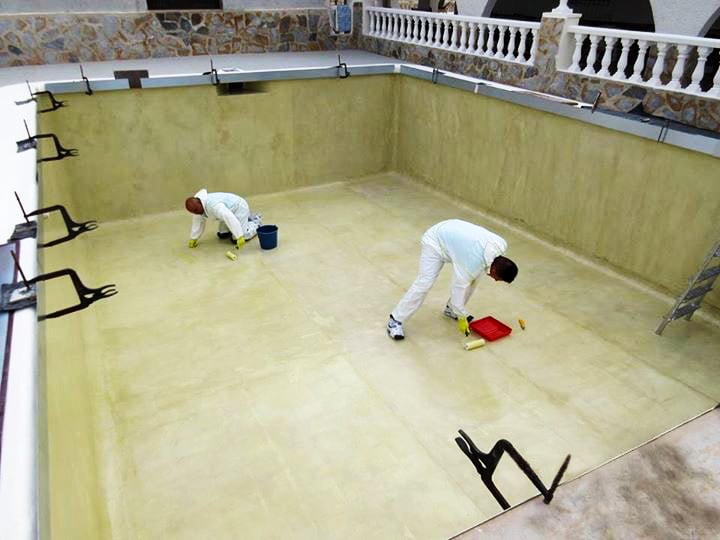How Long Does it Take For a Resurfaced Pool to Cure?

Are you wondering how long it takes for a resurfaced pool to properly cure?
This blog will guide you through the timeline, from the initial resurfacing to fully cured, ensuring your pool’s maintenance and longevity are on track. Keep reading to learn more!
Understanding the Pool Resurfacing Process
Pool resurfacing typically takes 5-7 days but can be affected by weather. Be sure to account for potential delays during the process.
Duration of pool resurfacing (5-7 days)
Resurfacing a pool typically takes 5 to 7 days, depending on the pool’s condition and size. Professionals mix and apply the new surface material within this timeframe. Weather can impact this schedule — adverse conditions might extend the process up to 14 days.
During resurfacing, teams meticulously prepare the pool by cleaning and repairing any damage before applying the new finish.
After applying the new surface, specialists begin filling the pool, marking the start of a crucial curing phase. The initial setting of materials like plaster happens quickly under water, taking about 7-10 days.
Potential delays due to weather
The pool resurfacing timeline can extend up to 14 days during adverse weather conditions. This makes the time of year you resurface very important. Professional care and preventive measures during this period are crucial in accelerating the curing process following adverse weather conditions or delays.
How Long Does it Take for a Resurfaced Pool to Cure?
A resurfaced pool typically takes around 30 days to cure, with some materials like quartz requiring additional time, while others are significantly quicker. When you can start swimming is also dependent on the chosen material. It’s crucial to follow proper maintenance and startup procedures for optimal curing, as well as steps.
Plaster curing process (usually 30 days)
With plaster, 60% of the curing or maturing process of a plaster finish occurs in the first 28 days and will continue over the next 8 to 10 months. During this time, it’s crucial to follow specific maintenance and startup procedures to ensure the longevity of the pool surface.
Proper care and treatment can stabilize the pH and alkalinity of the pool within about 30 days, contributing to the overall durability of the new surface.
Additional curing time for specific materials (ex. quartz)
For specific materials like quartz, the curing time can be longer than traditional pool plaster. While regular quartz finishes might require an additional 7-14 days for adequate curing.
Proper maintenance and adherence to recommended startup procedures are vital for ensuring the optimal curing of these specialized pool surfaces, which can significantly impact their longevity and performance.
Cure in minutes (ecoFINISH)
ecoFINISH coatings like aquaBRIGHT and polyFIBRO can dry almost immediately and cure in minutes, allowing you to refill the pool the same day. Its quick application and curing time are due to its innovative composition, which makes for a seamless installation process.
The ability of these pool finishes to dry almost immediately and cure in minutes makes them an ideal choice for those seeking a quick, durable, and visually appealing solution for their pool. With ecoFINISH, you can enjoy a beautifully resurfaced pool with minimal downtime and long-lasting benefits.

Importance of following proper maintenance and startup procedures for optimal curing
Proper maintenance and startup procedures are crucial for ensuring the optimal curing of a resurfaced pool. Following specific instructions for new pool surface is essential to guarantee proper curing and longevity of the surface.
The curing process can be accelerated with meticulous care, initial treatments, and tailored maintenance. By stabilizing the pH and alkalinity, these precise procedures underpin the long life of any pool surface.
Taking these measures will not only accelerate the curing process but also ensure that your investment in pool renovation or resurfacing stands robust against weather impacts and other complexities related to pool water chemistry.
Conclusion
Ensuring a resurfaced pool properly cures is essential for maintaining its longevity and functionality. The typical curing process varies depending on the material used:
- Traditional Plaster: Takes around 30 days to cure, with significant stabilization occurring in the first 28 days.
- Quartz Finishes: Require an additional 7-14 days beyond the standard curing period.
- ecoFINISH Coatings: Offer rapid curing, allowing the pool to be refilled the same day due to their advanced composition.
Proper maintenance and startup procedures are vital for optimal curing. This includes meticulous care, initial treatments, and maintaining the correct pH and alkalinity levels. Adhering to these guidelines ensures that the pool surface remains durable and aesthetically pleasing for years to come, despite weather-related challenges or other environmental factors.
By following these steps, you can maximize the lifespan and quality of your resurfaced pool, providing a safe and enjoyable swimming environment. Whether opting for traditional plaster, quartz, or the innovative ecoFINISH coatings, understanding the curing process and maintenance requirements is key to achieving the best results for your pool.
FAQs
The curing time for a resurfaced pool varies based on the materials used.
Factors such as weather conditions, type of materials used in the resurfacing, and proper maintenance can impact the duration of your pool’s curing process.
Proper maintenance during this period includes keeping track of water chemistry levels, avoiding harsh cleaning methods that could damage fresh surfaces, and adhering strictly to recommended waiting times before using your updated swimming spot.
While replastering is a form of resurfacing using plaster, resurfacing encompasses a wider range of materials and techniques to renew a pool’s interior.
